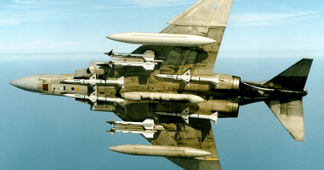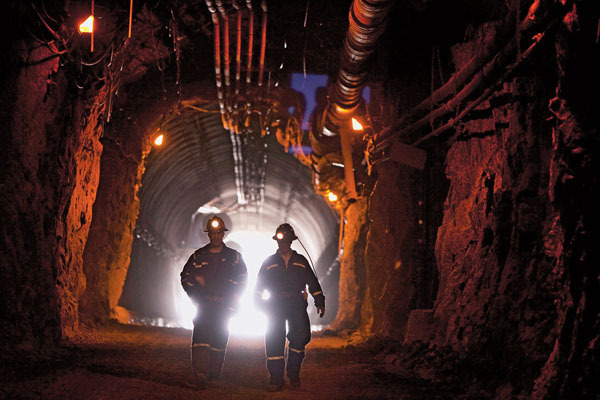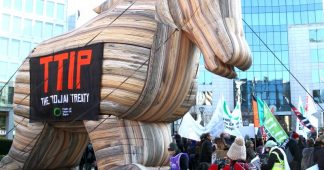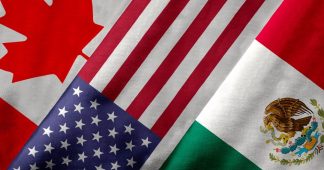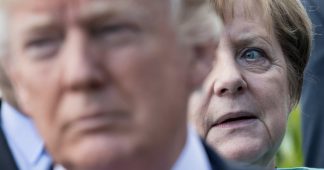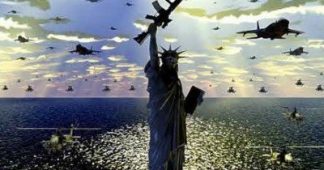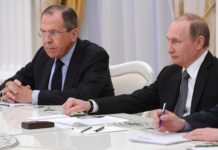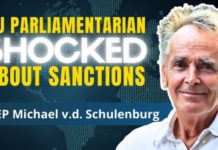Canadian imperialism flexes its muscles
By Benoît Tanguay
Published in www.marxist.com
When Justin Trudeau stated that, “Canada is back,” it could have been interpreted as just another one of those hollow phrases which he is so good at. With the unveiling of Canada’s new defence policy on June 7th, we now understand better what he meant.
As part of this new policy, the Trudeau government has announced massive increases in the defence budget, particularly the purchase of fighter jets and battleships. This indicates, above all, an important shift in Canadian foreign policy; in particular, the need for a more independent role in relation to the United States, as well as increased participation in imperialist wars. Turbulence on the international scene is causing the cards to be re-shuffled, and the Canadian bourgeoisie intends to take advantage of this to advance its interests
Feminist fighter jets
Apart from vague words and attempts to embellish imperialist violence (they even speak of “progressive, feminist foreign policy”), the document titled Strong, Secure, Engaged, contains important budgetary commitments. These commitments amount to increases in defence spending of $62.3 billion over the next 20 years. The defence budget will thus be increased to $18.9 billion in 2016-2017 and will reach a peak of 33.4 billion in 2027-2028 – an increase of 75%. This money serves not only to improve existing equipment and infrastructure, but also to purchase new weapons and increase the size of the armed forces.
The new policy aims to increase the size of the Canadian armed forces by 3,500 soldiers, 1,500 reservists and 605 new special operations personnel. In the field of military intelligence, 120 new posts will be created, most notably with the aim of improving Canada’s presence in cyberspace: “a purely defensive cyber posture is no longer sufficient” states the document.
Above all, the biggest part of the pie will go to the purchase of arms. A total of 88 fighter jets and surface combat vehicles will be purchased for the cost of 19 and 60 billion dollars respectively. The Liberals are more than doubling the arms spending contained in the Conservatives’ previous plan, which already included $9 billion for aircraft purchases and $26 billion for combat vessels. These purchases serve to double the proportion of the defence budget allocated to major equipment purchases from last year, increasing from 10.84 per cent in 2016-17 to 19.77 per cent in 2017-2018.
While Trudeau calls himself feminist and progressive, he spends billions of dollars taken from the pockets of Canadian workers on imperialist wars. Many people will be shocked by this militarist turn on the part of Trudeau, but this is not that surprising. This is not happening because Trudeau is a bloodthirsty warmonger but because Canada is a capitalist country with imperialist interests around the world. Trudeau must act to defend these interests, whether he calls himself a ‘feminist’ or not.
When workers demand higher wages, or better pensions or money for healthcare and education, we are told that the cupboards are bare. However, when it comes to buying fighter jets, battleships and hiring more soldiers to invade and bomb foreign lands and protect imperialist interests around the world, the money is easily found. This exposes point blank the hollow posturing of Trudeau who uses his progressive language to distract people from his real agenda. Only through fighting capitalism, can we fight against war and militarism and use these huge sums of money for the common good instead of destruction. A socialist program would spend these billions on healthcare, education, public transit, and modern infrastructure for native reserves.
Canadian militarism
This increase in military spending can be better understood in the light of the recent speech delivered in the House of Commons by Foreign Affairs minister Chrystia Freeland the day before. She announced a more active and independent role for Canada on the world stage, including on the military front, due to the upheavals suffered by the world “liberal, democratic” order. She began by outlining growing global instability, most notably with, “Russian military adventurism and expansionism,” the failure of western powers in Syria as well as in Ukraine, and the rise of China. Following this, Freeland, using veiled but harsh language, condemned the powerlessness of the United States to preserve the “postwar order” – in other words, the domination of the big western powers over half of the planet. Therefore, “For Canada that course must be the renewal, indeed the strengthening, of the postwar multilateral order.” The message sent by the minister is clear: the Canadian bourgeoisie can no longer rely on the United States to protect its imperialist interests. They need to look for other options.
The minister has thus announced a more active role for the Canadian military. It is with this in mind that we must understand the massive spending increases in the defence budget. “Canadian diplomacy and development sometimes require the backing of hard power,” she said, “To rely solely on the U.S. security umbrella would make us a client state.” Canada needs to have a “capable, professional and robust military” if it wants to have a say and not simply leave “the Great Powers to settle among themselves.” She announced that Canada would seek a two-year mandate on the UN Security Council. She also highlighted Canada’s military deployment in Latvia this summer. This NATO mission essentially consists of placing troops on the Russian border to act as cannon fodder, in order to justify Canadian intervention in the event of a Russian invasion of Europe.
The new defence policy aims to allow the Canadian armed forces to simultaneously lead, “two sustained deployments of approximately 500-1500 personnel in two different theatres of operation, including one as a lead nation,” in addition to several other smaller deployments of a shorter duration.
It must be noted that the desire of the Canadian bourgeoisie to make greater use of military force is nothing new. Previous defence policies in 2005 under the Liberals and 2008 under the Conservatives already increased the defense budget by 35% from 2005-2011. This allowed them to increase the size of the Canadian armed forces by several thousand as well as carry out major equipment upgrades. This tendency towards militarism was only halted by the economic crisis and the deficit reduction policy adopted by Harper as a result.
Canada is far from being the ”Care Bear” peacekeeping nation described in nationalist mythology. Although it is a middle power and it is far from spending as much on its armed forces as the United States, Canada remains an imperialist nation. It is one of the main imperialist forces in the mining industry in Africa and defends the interests of Canadian multinationals there whose abuses were revealed in the book Noir Canada. Canada played an important role in the coup d’etat against Jean-Bertrand Aristide in Haiti in 2004. Canada also participated in military missions in Afghanistan, Iraq, Libya and Syria.
The decline of the United States
Since the second world war, Canadian foreign policy has been intrinsically linked with that of its neighbour. More than 70% of Canada’s trade is with the United States as well as over 42% of foreign direct investment. Canada’s largest area of investment in the US is finance and insurance, totalling $131-billion in 2014. Canadian imperialism’s connection with US banks has meant that Canada gained a secondary dividend from the profits of US imperialism. The biggest catastrophe for the Canadian bourgeoisie would be anything that cuts off this flow of trade and dividends. From this position came a foreign policy closely aligned to that of the United States.
But the Canadian bourgeoisie cannot fail to notice the weakness of its traditional ally. The weakness of the United States is actually not a military one (no nation comes close to rivaling their military might), but a political one. The Trump presidency has reverted to a policy of US isolationism with the attempt to “Make America Great” at the expense of everyone else. The relative decline of American imperialism is marked by growing tensions between the big Western allied powers in NATO as they tend to become more and more independent from the United States. Donald Trump taking power has only added fuel to the fire. The recent NATO summit revealed the extent of the transatlantic divergences. At the meeting in Brussels, Trump sent a clear message to his allies.
Going against tradition during his speech at this meeting, Trump would not confirm his commitment to Article 5 of the North Atlantic treaty, central to NATO, which deals with the principle of collective defense between allies. The American president rather severely criticized his allies for failing to meet the minimum of 2% of GDP spent on defence required by NATO. The message to the European countries – continue in this direction and you will no longer be able to count on our protection – has only exacerbated the tensions. The declaration of German chancellor Angela Merkel upon exiting the summit demonstrated the breadth of the gulf which separates these great powers: “[Europe must] really take our fate into our own hands…The times in which we could rely fully on others — they are somewhat over” she said.
As Ivo H. Daalder of the Chicago Council on Global Affairs noted in the New York Times, “This seems to be the end of an era, one in which the United States led and Europe followed”. The New York Times pointed out: “With the United States less willing to intervene overseas, Germany is becoming an increasingly dominant power in a partnership with France.”
The rise of tensions between Europe and the United States is only the continuation of the slow decline of the American empire which has accelerated in recent years. The resounding failure of the adventure in Iraq and Afghanistan was followed by the intervention of Russia in Georgia in 2008, against which the US was powerless. Since then, the humiliations have accumulated. The coup d’etat in Ukraine should have been a relatively simple operation but it ended in the annexation of Crimea by Russia. In Syria, the inability of American imperialism to overthrow Bashar al-Assad and the subsequent passage of Turkey over to the side of Russia demonstrated that the giant has feet of clay. The recent hostility coming from the Philippines towards the United States – and the new orientation of the archipelago towards China – is another sign of the weakness of the American empire.
Canada’s new direction is part of the same determination recently expressed by Europe to no longer count on the United States. David Bercuson, of the Canadian Global Affairs Institute, pointed out in a letter in the Globe and Mail: “When Canada first joined the NORAD agreement back in 1959, we contributed about a third of the assets of the bi-national command…Today that contribution has slipped to under one-sixth. Everything else is done by the United States. We contribute about as little as we can get away with. Why? Because we take U.S. protection for granted. What if we can’t? What if Mr. Trump comes up with some new, ridiculous notion that if we don’t do more, the U.S. won’t cover the slack.”
A new commercial direction
But the clearest message from Chrystia Freeland’s speech in the House of Commons was that Canada now intends to set its “own clear and sovereign course.” While reaffirming Canada’s current commitments to the United States, Freeland indicated that they wanted to increase Canada’s participation in international organizations, in particular to bring Canada closer to Europe. To this end, she insisted on the importance of the Comprehensive Economic and Trade Agreement (CETA), “our historic trade agreement with the European Union.” Freeland also stated that CETA was just the beginning and that Canada would intensify its efforts to establish new trade agreements.
The American ruling class is in crisis and is fighting over the way to get out of the impasse. The arrival of Trump in the presidency, the abandonment of the Trans Pacific Partnership (TPP) and the rise of protectionist tendencies are an expression of this crisis. It has therefore become more and more risky for Canada to put all its eggs in the U.S. basket. The privileged trade relationship with the world’s leading power, which has benefited Canada until recently, is turning into a burden as the United States threatens to drag its northern neighbor down with them. The result is that Canada finds itself stuck with its main trading partner in a serious political crisis, headed by a fanatic willing to sabotage trade agreements at the foundation of the relationship between the two allies. The renegotiation of NAFTA and the reopening of the softwood lumber dispute can only confirm to the Canadian bourgeoisie that it is time to expand its trade horizons. CETA is particularly important in this respect, since it provides the opportunity for the Canadian bourgeoisie to forge more trade links with the second biggest market in the world.
The last few years have also seen Canada try to establish trade relations with Asian countries. Following the sabotage of the Trans Pacific Partnership (TPP) by Trump, Justin Trudeau spoke on the phone with his Japanese counterpart Shinzo Abe to establish a bilateral trade agreement. At the last Asia-Pacific Economic Cooperation (APEC) meeting in May, trade ministers from the other 11 countries of the deceased TPP, including Canada, agreed to discuss a revised version of the trade agreement, without the United States. In addition, other initiatives indicate an increased focus on Asia, including the establishment in Jakarta in 2016 of an embassy dedicated specifically to Canada’s relations with the Association of Southeast Asian Nations (ASEAN), which would pave the way for Canada’s inclusion in the Regional Comprehensive Economic Partnership (RCEP) between the ASEAN countries and China, Japan, South Korea, India, Australia and New Zealand. There are also the beginnings of exploratory discussions with China with the aim of forming a bilateral agreement.
Economic crisis, political crisis
Of course, it would be absurd to think that the Canadian bourgeoisie could conduct a foreign policy that is truly independant of the United States, especially with regards to the military. Canada has no military bases abroad. However, in a situation of economic and diplomatic turbulence and tension, and considering the presence of the unpredictable Trump in the White House, it becomes risky for the Canadian ruling class to depend too much on the United States. Conflicts within NATO, instability and wars in the Middle East, changes in historic allegiances, and tensions in the China Sea all point to storms on the horizon, of which the Canadian bourgeoisie is well aware.
The Canadian ruling class therefore has every interest in developing its military capabilities in order to defend its national interests in the coming conflicts that will inevitably emerge. Global instability means that the next few years will see other regional conflicts in which the great powers will re-divide the spoils of imperialism. The growing powerlessness of the United States offers an opportunity for Canadian imperialism to advance its pieces on the chessboard with greater independence.
Although Canada is not in a position to truly compete militarily with the big players, the ruling class hopes to use its military to both advance its own imperialist interests, most notably in Africa, where they are already present in the Democratic Republic of Congo and South Sudan, and as a bargaining chip with the United States. Considering the upcoming NAFTA renegotiation, as well as negotiations in the softwood lumber industry and the Boeing-Bombardier dispute, we can expect that Canadian imperialism will propose to participate in or conduct a military adventure with the United States, in exchange for compromise in the ongoing trade negotiations. Defense Minister Harjit Sajjan said recently that he is considering sending new troops to Afghanistan.
The uptick of the world economy has not been able to resolve the deep contradictions that undermine capitalism. Protectionist impulses demonstrate an attempt by the various national bourgeoisies to protect their domestic market, while the countless shenanigans and closed door negotiations to establish trade agreements indicate that they are playing a tug-of-war, trying to get a bigger share of the world market. This inevitably results in increased tensions and turbulence. Military force is sometimes the only way to solve these tensions. As Clausewitz put it, “war is the continuation of politics by other means.” To which Lenin added, “Politics is concentrated economics.”
